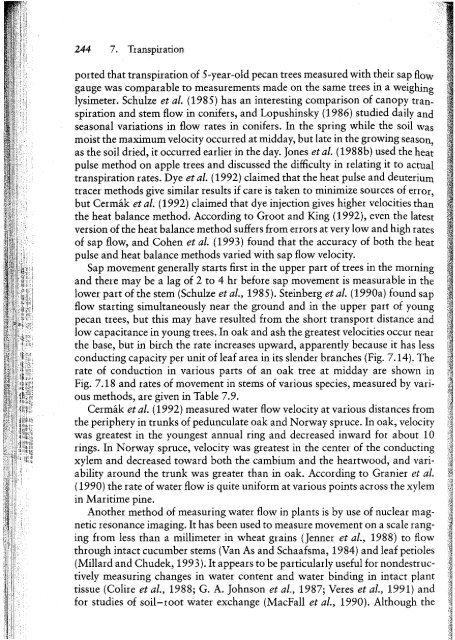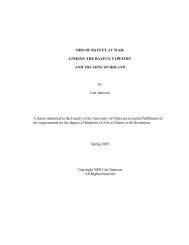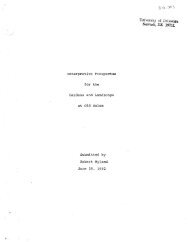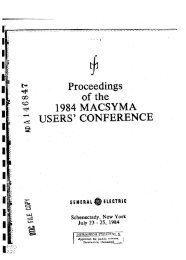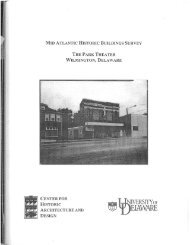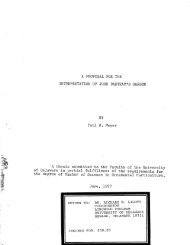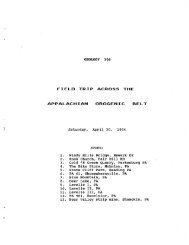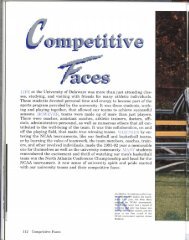Transpiration and the Ascent
Transpiration and the Ascent
Transpiration and the Ascent
You also want an ePaper? Increase the reach of your titles
YUMPU automatically turns print PDFs into web optimized ePapers that Google loves.
244 7. <strong>Transpiration</strong><br />
ported that transpiration of 5-year-old pecan trees measured with <strong>the</strong>ir sap flow<br />
gauge was comparable to measurements made on <strong>the</strong> same trees in a weighing<br />
lysimeter. Schulze et at. (1985) has an interesting comparison of canopy transpiration<br />
<strong>and</strong> stem flow in conifers, <strong>and</strong> Lopushinsky (1986) studied daily <strong>and</strong><br />
seasonal variations in flow rates in conifers. In <strong>the</strong> spring while <strong>the</strong> soil was<br />
moist <strong>the</strong> maximum velocity occurred at midday, but late in <strong>the</strong> growing season,<br />
as <strong>the</strong> soil dried, it occurred earlier in <strong>the</strong> day. Jones et at. (1988b) used <strong>the</strong> heat<br />
pulse method on apple trees <strong>and</strong> discussed <strong>the</strong> difficulty in relating it to actual<br />
transpiration rates. Dye et at. (1992) claimed that <strong>the</strong> heat pulse <strong>and</strong> deuterium<br />
tracer methods give similar results if care is taken to minimize sources of error,<br />
but Cermak et at. (1992) claimed that dye injection gives higher velocities than<br />
<strong>the</strong> heat balance method. According to Groot <strong>and</strong> King (1992), even <strong>the</strong> latest<br />
version of <strong>the</strong> heat balance method suffers from errors at very low <strong>and</strong> high rates<br />
of sap flow, <strong>and</strong> Cohen et at. (1993) found that <strong>the</strong> accuracy of both <strong>the</strong> heat<br />
pulse <strong>and</strong> heat balance methods varied with sap flow velocity.<br />
Sap movement generally starts first in <strong>the</strong> upper part of trees in <strong>the</strong> morning<br />
<strong>and</strong> <strong>the</strong>re may be a lag of 2 to 4 hr before sap movement is measurable in <strong>the</strong><br />
lower part of <strong>the</strong> stem (Schulze et at., 1985). Steinberg et at. (1990a) found sap<br />
flow starting simultaneously near <strong>the</strong> ground <strong>and</strong> in <strong>the</strong> upper part of young<br />
pecan trees, but this may have resulted from <strong>the</strong> short transport distance <strong>and</strong><br />
low capacitance in young trees. In oak <strong>and</strong> ash <strong>the</strong> greatest velocities occur near<br />
<strong>the</strong> base, but in birch <strong>the</strong> rate increases upward, apparently because it has less<br />
conducting capacity per unit of leaf area in its slender branches (Fig..7.14). The<br />
rate of conduction in various parts of an oak tree at midday are shown in<br />
Fig. 7.18 <strong>and</strong> rates of movement in stems of various species, measured by various<br />
methods, are given in Table 7.9.<br />
Cermak et at. (1992) measured water flow velocity at various distances from<br />
<strong>the</strong> periphery in trunks of pedunculate oak <strong>and</strong> Norway spruce. In oak, velocity<br />
was greatest in <strong>the</strong> youngest annual ring <strong>and</strong> decreased inward for about 10<br />
rings. In Norway spruce, velocity was greatest in <strong>the</strong> center of <strong>the</strong> conducting<br />
xylem <strong>and</strong> decreased toward both <strong>the</strong> cambium <strong>and</strong> <strong>the</strong> heartwood, <strong>and</strong> variability<br />
around <strong>the</strong> trunk was greater than in oak. According to Granier et at.<br />
(1990) <strong>the</strong> rate of water flow is quite uniform at various points across <strong>the</strong> xylem<br />
in Maritime pine.<br />
Ano<strong>the</strong>r method of measuring water flow in plants is by use of nuclear magnetic<br />
resonance imaging. It has been used to measure movement on a scale ranging<br />
from less than a millimeter in wheat grains (Jenner et at., 1988) to flow<br />
through intact cucumber stems (Van As <strong>and</strong> Schaafsma, 1984) <strong>and</strong> leaf petioles<br />
(Millard <strong>and</strong> Chudek, 1993 ).It appears to be particularly useful for nondestructively<br />
measuring changes in water content <strong>and</strong> water binding in intact plant<br />
tissue (Colire et at., 1988; G. A. Johnson et at., 1987; Veres et at., 1991) <strong>and</strong><br />
for studies of soil-root water exchange (MacFall et at., 1990). Although <strong>the</strong>


